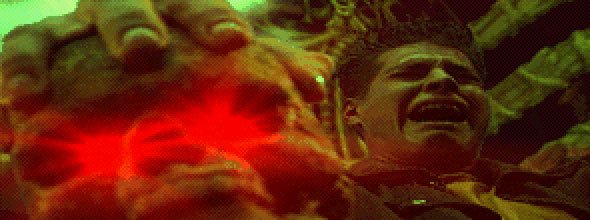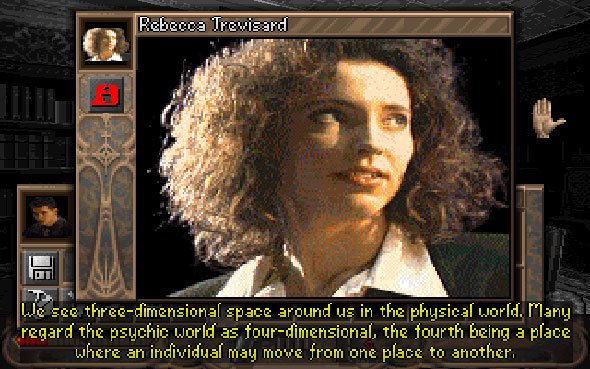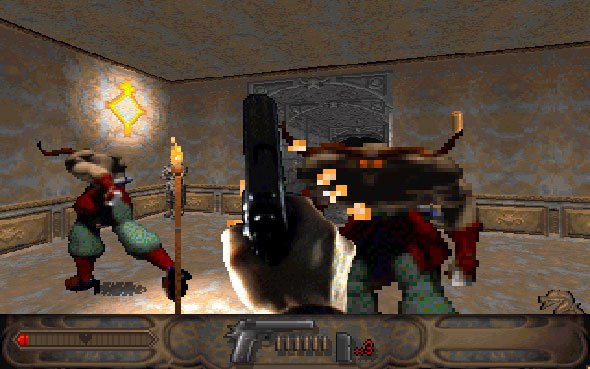Crapshoot: Realms of the Haunting, the FMV horror game that's not all bad
We're rerunning Richard Cobbett's classic Crapshoot column, in which he rolled the dice and took a chance on obscure games—both good and bad.

From 2010 to 2014 Richard Cobbett wrote Crapshoot, a column about bringing random obscure games back into the light. Here he heads out in search of some chills in one of the quirkiest horror games that almost nobody played, and a ghost story that's out of this world.
As a self-proclaimed wuss, horror's never really been my genre. I don't like jump-scares. I'm squeamish about gore effects. I don't get any enjoyment from watching people being sliced open. I don't understand why the world needs so many Saw films, or how the villains have managed to avoid suffering from psychopath's block. After so many sadistic puzzles, even the cleverest serial killer would be forgiven for just wheeling out a bear-trap and slapping on a Post-It that says "Stick Face Here".
Despite this, when I think back to the games that deserved a better reception, Realms of the Haunting is one of the first that jumps into my mind. It was amazing. It was terrible. It was clever. It was insane. It merged adventuring and shooting in a way that no other game has ever really tried—including its semi-spiritual sequel Clive Barker's Undying. It was an exquisitely crafted experience and one of the sloppiest games ever all at once. It was beautiful in its chaos, and I loved it, pustular warts and all.
At first glance, Realms of the Haunting is the most cliched kind of horror story. You play Adam Randall, a young man drawn into a big spooky mansion by nightmares, the death of his father, and a box of broken seals. As soon as you get inside, the doors slam behind you, revealing doors locked by magic sigils, typewriters rattling off spooky messages, and carefully planted books with names like 'Look Homeward Angel' hammering home the dark atmosphere.
It's all very generic, but oddly effective considering the Doom level engine (that was at least two years out of date when ROTH hit the shelves in 1996), largely due to phenomenal audio direction on everything from dead rats being crunched underfoot to the satisfying 'kachunk' of picking up a box of ammo. It's never a particularly pretty game, although it does some clever things with contrast that mean certain areas impress, but it still has its charms.
What really makes it work is that ROTH is a very smart game, especially when it comes to its characters. Adam is one of the best everymen in gaming history. Right in the intro when we see that he's not entering the situation blind. He doesn't know he's about to set foot in a house full of angry demons, but he's done what research he could, and at least tried to prepare himself. Where other characters would take the words of a spooky priest on faith, Adam's called around and confirmed what he said was a complete lie. He's grabbed some textbooks and tried to find out about the broken seals, even if he's come up blank.
Throughout the long taxi journey that makes up most of the opening, his expression says it all—a mix of determination, confusion, and understandable trepidation. He's no Gabriel Knight, but he's competent enough company for a trip into the unknown.
Keep up to date with the most important stories and the best deals, as picked by the PC Gamer team.

As simple as the engine is, the mansion built with it is fantastic. It's a huge, sprawling place, with no loading screens or level boundaries getting in the way. It feels like almost every room had a purpose, from the dormitories to the creaking laboratories, underground caverns, and huge Satanic temple in the basement which runs with molten lava. It's a place of buried secrets, a focal point in the war between Good and Evil, and one with a genuine sense of history. Books, letters, maps and other documents fill in many of the gaps, from what happened to bigger truths, like the fact that the house is filled with portals to other realms of existence. The more you explore and learn, the more the game evolves away from its haunted house origins and into something much more fantastical—a huge-scale race to prevent an ancient French sorcerer ushering in Armageddon, and worse, being insufferably smug about it.
Cleverly, the evolution takes place everywhere. While the haunted house remains the game's hub, and the dark atmosphere remains effective throughout, ROTH knows better than to keep trying cheap scares. Even Adam gets used to them. When you first see the demons jump out of the floor to gut you, he swears and reacts to them. After the first couple, both of you start taking them in stride.
Instead, ROTH constantly finds new ways to keep you off balance, from stepping into new worlds, to developments in the plot, and the addition of new characters to help or hinder your progress. You never know what's coming next, where you're going, or which bits of mythology you've gleaned from exploring will be relevant. The army of flying bat monsters in the basement for instance—part of the big plan, or just the villain's old demonic contacts still hanging around? You're never entirely sure.

It helps that the characters themselves are more than you'd expect—sometimes a little dull and earnest, especially the goodies, but most with a clever twist or unexpected spark of humanity. One of the first you meet is called the Gnarl, a cranky hooded figure in a small pocket dimension. He challenges Adam to take a test to prove his worthiness to travel to other realms. Adam reluctantly agrees. The Gnarl just snaps, "Done. I tire of triviality..." and invites you to get out of his face.
Even better is when you find yourself in the presence of Raysiel, the universe's jailor, who sternly tells you that you can only have what you need from his castle if you can make it through in silence. Fail (and that's quite likely since his castle is room after room of gongs, sirens, nightingale floors and other traps) and the punishment is to be locked away until the end of time. He'll do it too... but he's not without a heart. If you screw up—just once, mind—he'll let you off with a "Someone treads my hall. It is the son of Adam. Be warned, boy. The need of your realm is great; tread softer. So be the gift of the Master Jailer."
What a nice guy. Almost makes you want to forgive him for his sadistic garden maze.

By far ROTH's best twist on horror gaming is that you're rarely alone. Early on you bump into a young woman in the mansion—psychic Rebecca Trevisard—who joins up with Adam, and makes exploring a far less lonely affair. You don't actually see her in the gameworld, even if you look in a mirror, but she's meant to be standing behind you.
The two banter constantly, sharing thoughts on the developing story, on the characters you meet, and anything else of interest. ROTH's mansion is packed with detail, from paintings to decorations, machines and ancient shrines, and you can chat about all of them with a click. Not only that, you can open up your inventory and swap notes on everyone you've met, every weird occurrence, every bit of backstory or key document you've found, and the conversations develop throughout the game as you uncover the truth. This really boosts the adventuring element, letting the weak shooting feel like a little spice.
For all that the backstory is nonsense about Templar knights and magic spirit crystals, lots of work clearly went into making it feel coherent, and Rebecca is always on hand to explain the details. Unsurprisingly, this helpful lady standing around in the middle of a demon-filled house ends up knowing far more than she's letting on, but the friendship between the two characters is genuine, and makes exploring both the mansion and its attached worlds so much more enjoyable than if it was just Adam charging around going "What the hell?" at all the weirdness.

The second best addition is Belial, a demon lord played by David Learner. If you're a certain age from the UK you'll instantly recognise him as Pickle, Treguard of Dunshelm's elf assistant from Knightmare. Realms of the Haunting makes Pickle scary.
I shall repeat that. This game makes Pickle scary.
Belial gets one of the best villain introductions in the history of gaming. He appears in the darkness of a huge underground shrine, stone-faced, bespectacled and wearing a pristine lab coat. As he approaches, shoes clicking against the stone temple floor, you see him purposefully slide on dusty gloves of branded human skin—the only way he can touch a holy relic you spend most of the game carting around. With his opening lines, he sneers at Adam and Rebecca, telling them flat-out that he has no interest in winning their trust, unlike previous characters. Then we get this utterly delicious exchange:
"I am... Belial. As to what I want... well, that can wait a little longer, while we have some fun. Humans do still bleed, don't they? Splendid..."
Suddenly, you wouldn't want to be in Majida's shoes. Or presence. But no change there. Belial is a fantastic villain, even though he's only the real baddie's lieutenant. His boss... is less impressive, not least because it's hard to be scared of a guy named Claude. Pity. So sad.
As an actual game, Realms of the Haunting is severely flawed. The monster AI is so bad that enemies can't generally follow you through doors. If you run straight past, they'll never catch you. It has more than a few outright cruel moments, where something will just crush or blast you without warning, and not much in the way of health potions. It loves its mazes, and some of them are quite literally hell to get through. One of the last takes place in a realm called Sheol, in a huge sprawling maze designed to look like a brain. Your task is to find 16 brains scattered around its monster-filled halls and drop them into a big brain machine, which opens the door to the next level. It's exactly as much fun as it doesn't sound.
The great thing is that even when ROTH is bad, it's bad in mindblowingly strange ways. It's a game where a whole world is devoted to—no word of a lie—making a mystical bong. It's a game which quickly gets bored of guns with ammo and just gives you recharging weapons, except for the most powerful, which can never, ever be reloaded. Whether or not you have shots left is the difference between the final boss going down in a couple of hits, and tearing your face off with a couple of blows.

Most bizarre of all though is the bit where you apparently fall through reality and land in a hellish version of The Crystal Maze. The third level of Sheol is a hub surrounded by challenge rooms, which you have to complete to reach the boss fight with Belial (in which he goes down in seconds due to not actually being able to move). These challenges include machine puzzles, platforming, mirror mazes and... a coconut shy. You're right on the edge of saving the world, and ROTH forces you to play a coconut shy before fighting the Lord of Lies!
That's the problem with a game that constantly evolves: sometimes it grows a penis where its face is meant to be. Still, as late-game insanities go, it's not one you're likely to have seen elsewhere.
At the time, none of this mattered. If you were playing 'properly', you wouldn't notice the AI not working, and for every stupid bit, there was something great and memorable just round the next corner. Realms of the Haunting had many problems, but it also had soul, and it's that soul that stuck in players' memories after the horrors of brain mazes and incompetent monsters finally faded. If ever a PC game deserved to be remembered as a diamond in its own rough, it's this one. Toast it, remember it, and maybe play a little Deadly Premonition in its honour.
Alternatively, just enjoy the entire game courtesy of Kikoskia's fine Let's Play:
(Honestly, a ****ing coconut shy. What the hell were they thinking?!)

